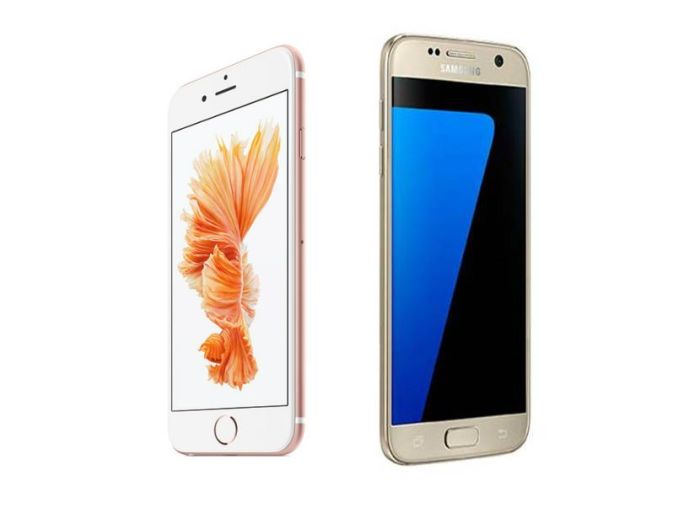Galaxy S7 outsells iPhone 6s – a statement that reverberated throughout the tech world, marking a significant shift in the smartphone landscape. This analysis delves into the factors that contributed to the Galaxy S7’s triumph, examining its key features, marketing strategies, and consumer preferences. We’ll explore how Samsung capitalized on market trends and technological advancements to outmaneuver Apple and capture a larger share of the smartphone market.
From sales figures and market share to innovative features and consumer feedback, we’ll dissect the reasons behind the Galaxy S7’s success, shedding light on the strategic decisions and market forces that played a pivotal role.
Technological Advancements: Galaxy S7 Outsells Iphone 6s
The Galaxy S7 and iPhone 6s were released in 2016, and while both were considered top-tier smartphones, the Galaxy S7 featured several technological advancements that set it apart from its Apple counterpart. These advancements significantly impacted the user experience and contributed to the Galaxy S7’s commercial success.
MicroSD Card Support
The Galaxy S7 offered expandable storage through a microSD card slot, a feature absent in the iPhone 6s. This allowed users to increase their device’s storage capacity beyond the built-in limit, catering to those who needed more space for photos, videos, and apps.
Water and Dust Resistance
The Galaxy S7 was IP68 certified, meaning it was resistant to water and dust. This was a significant advancement, as it provided users with peace of mind, allowing them to use their phones in various environments without worrying about accidental damage. The iPhone 6s, on the other hand, lacked this feature, making it more susceptible to water damage.
Faster Processor
The Galaxy S7 was equipped with a more powerful processor than the iPhone 6s, resulting in smoother performance and faster app loading times. This improved user experience, particularly for demanding tasks like gaming and multitasking.
Dual Pixel Autofocus
The Galaxy S7’s camera featured a dual-pixel autofocus system, which significantly improved the speed and accuracy of focusing. This resulted in sharper and more detailed photos, particularly in low-light conditions.
Always-On Display, Galaxy s7 outsells iphone 6s
The Galaxy S7 introduced an always-on display feature, which allowed users to view basic information like time, notifications, and missed calls without needing to unlock their phone. This provided a convenient way to stay informed without draining the battery significantly.
Conclusion
These technological advancements, along with other features like a larger battery capacity and a more advanced camera sensor, contributed to the Galaxy S7’s success in the market. They provided users with a more versatile and enjoyable experience, making the Galaxy S7 a compelling choice over the iPhone 6s.
Long-Term Impact and Legacy
The Galaxy S7’s triumph wasn’t just a one-time success. It significantly shaped Samsung’s brand image and influenced the direction of the smartphone industry. This success had a profound impact on Samsung’s trajectory, solidifying its position as a leading innovator in the mobile technology space.
Impact on Samsung’s Brand Image and Market Position
The Galaxy S7’s success cemented Samsung’s position as a top contender in the smartphone market. Its innovative features and premium design contributed to a positive perception of the brand. The phone’s popularity also helped Samsung gain market share, challenging Apple’s dominance. The Galaxy S7’s success also helped Samsung establish itself as a leading innovator in the smartphone industry. The phone’s innovative features, such as its water-resistant design and expandable storage, were widely praised and helped Samsung gain a reputation for pushing the boundaries of what a smartphone could do.
Influence on Subsequent Samsung Flagship Devices
The Galaxy S7’s success influenced the development of subsequent Samsung flagship devices in several ways. The phone’s success demonstrated the importance of a premium design, innovative features, and a user-friendly interface. This led Samsung to prioritize these aspects in its future flagship devices. For example, the Galaxy S8, released in 2017, featured an even more refined design and a larger display, building upon the foundation laid by the Galaxy S7.
Contribution to the Evolution of the Smartphone Market
The Galaxy S7’s success contributed to the overall evolution of the smartphone market in several ways. Its success helped to popularize features like water resistance and expandable storage, which are now common in many flagship devices. It also set a new standard for premium smartphone design and performance, pushing other manufacturers to innovate and compete. The phone’s success also helped to fuel the growth of the smartphone market as a whole.
End of Discussion
The Galaxy S7’s victory over the iPhone 6s wasn’t just a matter of chance. It was a testament to Samsung’s strategic approach, understanding consumer needs, and leveraging technological advancements. This success solidified Samsung’s position as a leading player in the smartphone market, influencing both the industry and consumer preferences for years to come. As we look back on this pivotal moment in smartphone history, we gain valuable insights into the ever-evolving dynamics of the tech landscape.
The Galaxy S7’s popularity seems to be rivaling the iPhone 6s, with reports showing it outsold its competitor in the first quarter of 2016. Meanwhile, gamers are eagerly awaiting the release date for the next Fallout 4 DLC , which is expected to bring even more exciting content to the post-apocalyptic world.
While technology and gaming worlds are buzzing with excitement, it’s interesting to see how these two distinct industries continue to capture the attention of consumers.
 Securesion Berita Informatif Terbaru
Securesion Berita Informatif Terbaru
